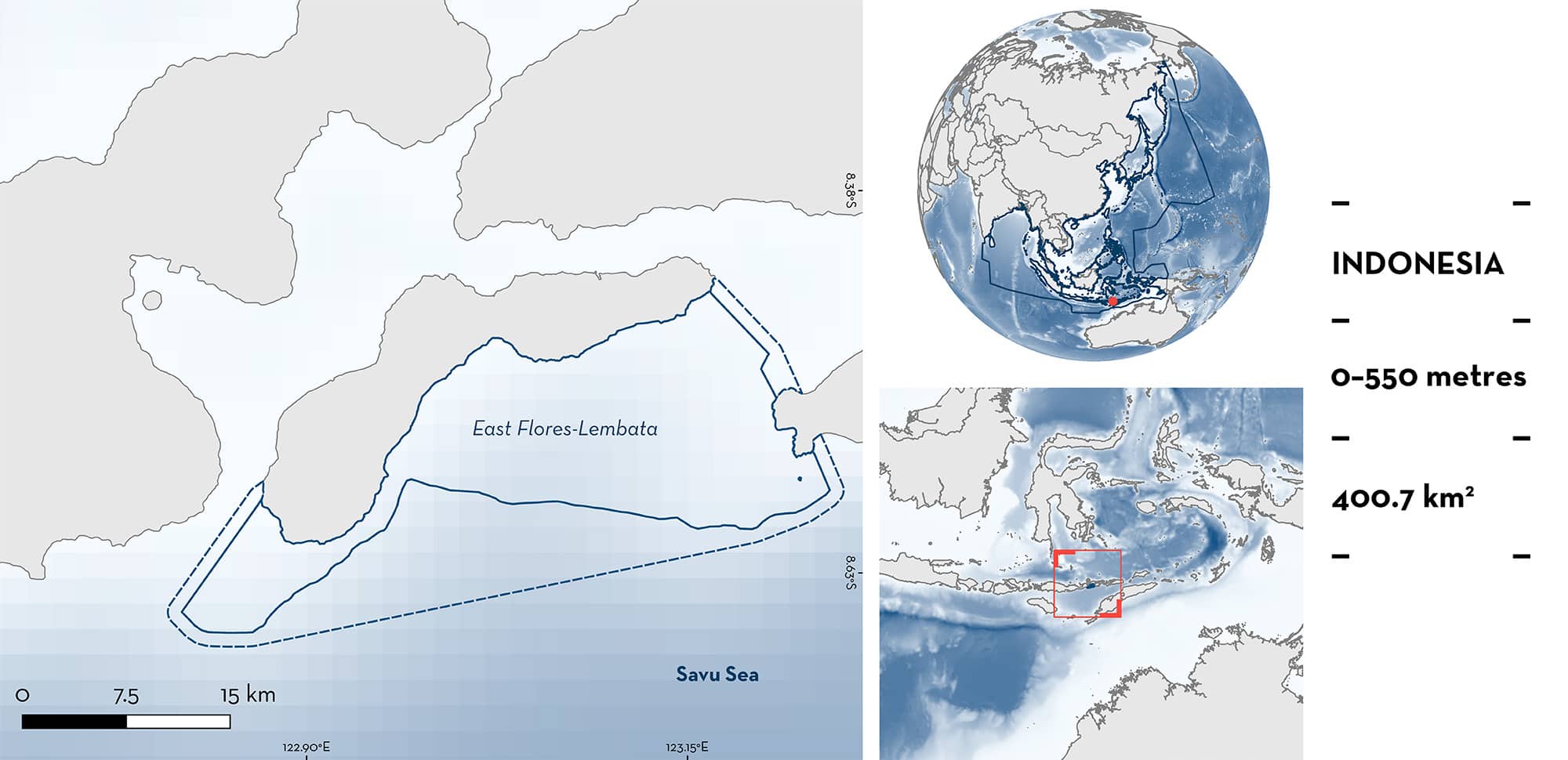ISRA FACTSHEETS
ISRA FACTSHEETS
ASIA REGION
East Flores-Lembata
Summary
East Flores-Lembata is located in eastern Indonesia and is part of the Lesser Sunda islands. It sits within the Savu Sea and is characterised by a narrow continental shelf and a gentle slope with high productivity due to seasonal upwelling. The area overlaps with two marine protected areas. Within this area there are: threatened species (e.g., Spinetail Devil Ray Mobula mobular); and feeding areas (e.g., Sicklefin Devil Ray Mobula tarapacana).
Download factsheet
East Flores-Lembata
DESCRIPTION OF HABITAT
East Flores-Lembata is located in eastern Indonesia and is part of the Lesser Sunda islands. It sits within the Savu Sea in the East Nussa Tenggara Province and includes the east side of Flores Island, Solor Island, and the western side of Lembata (Putra & Mustika 2020). The area is characterised by a narrow continental shelf and a gentle slope with high productivity in the break between them.
The area is influenced by the Indonesian Throughflow, which flows through the Ombai Strait producing seasonal upwelling, which, combined with the bathymetry of the area, internal tides, and vertical mixing, increase the productivity of the area between March and August (Molcard et al. 2001; Moore & Marra 2002; Putra & Mustika 2020).
This area overlaps with two marine protected areas, Pulau Lembata and Suaka Alam Perairan Kabupaten Flores Timur Marine Nature Reserve.
This Important Shark and Ray Area is pelagic and is delineated from inshore and surface waters (0 m) to 550 m based on the bathymetry of the area.
CRITERION A
VULNERABILITY
Three Qualifying Species considered threatened with extinction according to the IUCN Red List of Threatened Species regularly occur in the area. These are the Endangered Oceanic Manta Ray (Marshall et al. 2022a), Spinetail Devil Ray (Marshall et al. 2022b), and Sicklefin Devil Ray (Marshall et al. 2022c).
CRITERION C
SUB-CRITERION C2 – FEEDING AREAS
East Flores-Lembata is an important feeding area for three ray species.
Opportunistic observations of stomach contents from Oceanic Manta Ray (n = 1), Spinetail Devil Ray (n = 7), and Sicklefin Devil Ray (n = 1) caught by fisheries operating in the area in 2018 confirmed the presence of fresh krill (Misool Foundation unpubl. data 2023), indicating that devil rays fed on krill in this area. This area holds the largest small-scale fishing community in Indonesia that regularly catch these three ray species (Dewar 2002; Lewis et al. 2015). Based on local ecological knowledge from fishers, the fishery for devil rays has intensified since 2002 due to fleet expansion and the commercialisation of gill plates (Dewar 2002; Putra et al. 2020; Booth et al. 2021).
Monitoring of landing and catch (on-board observations) data between 2015–2018 revealed that all three species are caught from April to November in the area with a higher occurrence of aggregations between May–September (Putra & Mustika 2020; Misool Foundation unpubl. data 2023), which coincides with the months of higher zooplankton biomass in the area. This increase in zooplankton is related to upwelling, and the level of productivity is higher than in other places within the region (Putra et al. 2020). Feeding aggregations of Oceanic Manta Ray (n = 392 recorded in landing monitoring) occur from May to November, while those of Spinetail Devil Ray (n = 906) occur from April to November, and Sicklefin Devil Ray (n = 152) from May to August.
Based on daily landing observations and on-board observations from 2015–2017, the three species favour habitats near the 200 m isobath with higher chlorophyll-a concentration, suggesting a higher density of prey in this area (Putra et al. 2020). For the Oceanic Manta Ray, there is also a preference for gentle slopes and shallow productive waters influenced by coastal upwelling and tidal currents, generating high-density zooplankton biomass (Putra et al. 2016).
Download factsheet
SUBMIT A REQUEST
ISRA SPATIAL LAYER REQUEST
To make a request to download the ISRA Layer in either a GIS compatible Shapefile (.shp) or Google Earth compatible Keyhole Markup Language Zipped file (.kmz) please complete the following form. We will review your request and send the download details to you. We will endeavor to send you the requested files as soon as we can. However, please note that this is not an automated process, and before requests are responded to, they undergo internal review and authorization. As such, requests normally take 5–10 working days to process.
Should you have questions about the data or process, please do not hesitate to contact us.


